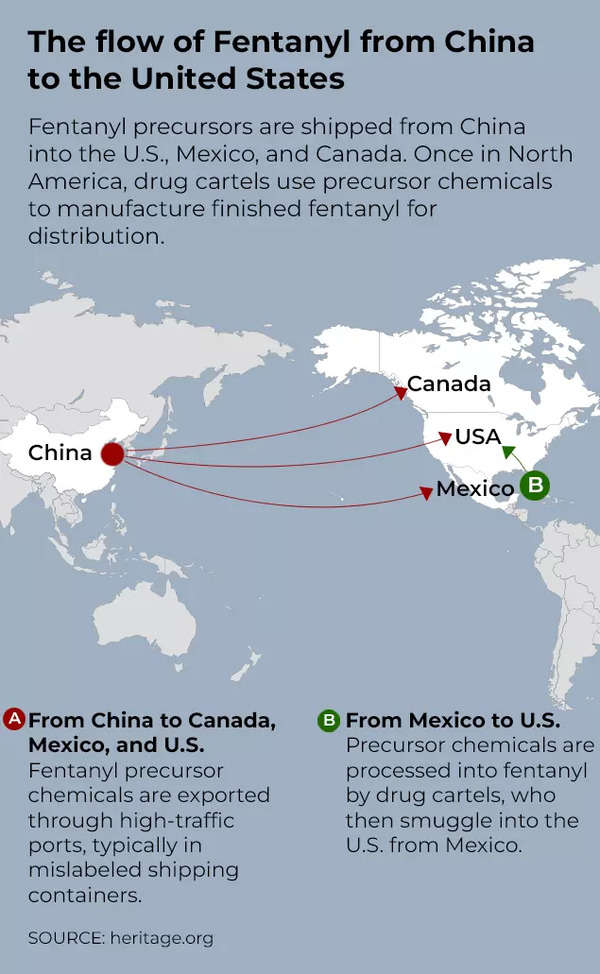World
200 deaths/day, $1.5 trillion per year: How China is destroying US families with deadly drug fentanyl – Times of India

The United States is grappling with an unprecedented drug epidemic, primarily driven by fentanyl and other opioids. These substances are responsible for claiming the lives of more than 1,500 Americans every week, making them the primary cause of fatal overdoses nationwide.
Driving the news

Driving the news
- In recent years, illicit fentanyl, a highly potent synthetic opioid, has become the face of this crisis. The illegal fentanyl supply is predominantly manufactured in China and Mexico before being smuggled into the United States.
- The
US fentanyl crisis , which led to over 108,000 overdose deaths in 2023, has reached a critical point as mounting evidence shows direct involvement from both China and Mexico. - Chinese precursor chemicals play a crucial role in the supply chain that brings lethal fentanyl to the United States, even though the two countries are separated by the vast expanse of the Pacific Ocean.
- According to a Heritage foundation report, Chinese chemical companies are supplying Mexican cartels with the precursors needed to produce fentanyl, which is then smuggled across the US border.
- This partnership between two foreign actors—one a geopolitical adversary and the other a nation plagued by organized crime—is fueling a public health and national security crisis that has proven difficult for the US to contain.
Why it matters
- Fentanyl is now the “deadliest drug threat the United States has ever faced,” according to the US Department of Justice. Of the 108,000 overdose deaths recorded in 2023, synthetic opioids like fentanyl were responsible for over 75,000 of them.
- The drug’s lethality and its ease of production and distribution have exacerbated its impact, with nearly 200 Americans dying every day from fentanyl overdoses.
- “The nearly 200 Americans who continue to die every day from fentanyl overdoses represent an assault on the societal, political, and economic health of the United States,” the report said.
- The broader opioid epidemic cost the US economy approximately $1.5 trillion in 2020 alone, a figure that has only risen in the years since.
- The fentanyl crisis not only poisons individuals but also undermines the US economy, healthcare system, and social fabric.
- “US adversaries are establishing a new avenue of asymmetric warfare against the American people through which they can launch destabilizing actions against the United States,” the report said.
The big picture
- The fentanyl crisis is the result of an intricate global supply chain, linking China’s biopharmaceutical industries to Mexican drug cartels and eventually to American streets.
- Chinese companies produce and export fentanyl precursor chemicals, which are then shipped to Mexico. There, cartels process the chemicals into fentanyl and smuggle the finished product into the United States.
- The cartels, particularly the Sinaloa and Jalisco organizations, have longstanding trafficking infrastructures that enable them to move vast quantities of the drug across the US-Mexico border, utilizing air and sea cargo, vehicular traffic, border tunnels, and stash houses.
- The Chinese Communist Party (CCP) plays a central role in this crisis. Despite committing to regulate fentanyl production in 2019, China has failed to enforce meaningful oversight on its biopharmaceutical companies.
- Reports indicate that Chinese chemical companies provide over 80% of methamphetamine precursors to Mexican cartels, and a recent congressional investigation found that the CCP offers subsidies to encourage the export of these dangerous chemicals.
- Since at least 2018, the CCP has provided tax rebates for the export of fentanyl precursors, increasing these subsidies to 13% in 2020. Despite laws in both the US and China prohibiting these exports, Chinese companies continue to ship the necessary chemicals to Mexico, often using sophisticated methods to evade detection.
- Chinese criminal organizations have become more directly involved in the fentanyl trade within the Western Hemisphere, particularly in Canada. This increased activity is evident in cities like Toronto, where these groups have taken on a greater role in various aspects of the fentanyl supply chain, including “smuggling, production, and distribution of fentanyl”.

Zoom in: Mexico’s complicity
- Mexican cartels have benefited from a permissive environment within their own country. Corruption among Mexican officials, including local police forces and top military personnel, has created a haven for cartel operations. The administration of Mexican President Andrés Manuel López Obrador has done little to combat the cartels. His “hugs, not bullets” strategy has led to a reduction in military and law enforcement efforts to dismantle cartel operations. In fact, recent investigations have shown that many of the drug labs raided by Mexican authorities were inactive, suggesting a lack of genuine effort in addressing the crisis. Meanwhile, the Biden Administration has largely refrained from putting significant pressure on Mexico to act more forcefully against the cartels.
- The cartels’ operations are sophisticated and multifaceted. After receiving precursor chemicals from China, they process fentanyl in clandestine labs scattered across Mexico, often in remote or well-protected areas. These drugs are then smuggled into the United States using a variety of methods, including air and sea cargo, pedestrian traffic, and tunnels. Once the drugs cross the border, cartel-linked distribution networks inside the US help move the product to consumers, while also laundering the illicit proceeds. The money laundering side of the operation is equally complex, often involving Chinese money laundering organizations that repatriate drug money through the Chinese financial system, further complicating US enforcement efforts.
What they are saying
- The US House Select Committee on Strategic Competition between the United States and the Chinese Communist Party released a report in April 2024 detailing China’s role in the fentanyl epidemic. “The CCP directly subsidizes the manufacturing and export of illicit fentanyl materials and other synthetic narcotics,” the report said.
- Additionally, the committee discovered that China’s chemical companies are actively engaged in smuggling these substances to Mexico, where Mexican cartels process them into fentanyl. US officials have expressed frustration with China’s lack of action. “Despite the evidence that the CCP promotes the export of illicit chemicals, the Biden Administration has sought to ‘work with’ China on its complicity in the fentanyl epidemic,” the report added.
- On the Mexican side, the Drug Enforcement Agency (DEA) has made it clear that Mexico’s cartels are the main drivers of the fentanyl crisis. “Mexican drug cartels are the main driver behind the ongoing epidemic of drug poisoning deaths in the United States,” the DEA said in its 2024 National Drug Threat Assessment.
- These cartels have rapidly integrated fentanyl into their existing trafficking operations, using their well-established routes to move the drug across the US border. The Sinaloa and Jalisco cartels, in particular, dominate the fentanyl trade, with the help of Chinese criminal groups and corporations. Corruption within Mexico’s government and law enforcement allows the cartels to operate with impunity, making it difficult for US officials to stem the flow of fentanyl into the country.
What’s next
- The fentanyl crisis will not abate without aggressive and proactive measures by the US. So far, diplomatic efforts have failed to significantly curb the flow of fentanyl into the country. In November 2023, following a meeting between President Biden and Chinese President
Xi Jinping , China agreed to form the US-China Counternarcotics Working Group. However, past efforts to collaborate with China have often yielded little more than empty promises, with Chinese companies continuing to find ways around regulations. Mexican efforts, too, have been underwhelming, as corruption remains rampant and cartel operations continue unabated. - To effectively combat the crisis, the US must recognize that it lacks reliable partners in both China and Mexico. The US should prioritize going after fentanyl money by increasing the number of financial investigators dedicated to tracking Chinese and Mexican traffickers. Exposing the depths of corruption in Mexico’s government and applying targeted sanctions on corrupt officials could disrupt cartel operations. Similarly, the US should push for increased transparency in China’s pharmaceutical and chemical industries, imposing tariffs and stricter inspection requirements on Chinese imports related to the biopharmaceutical sector, the Heritage Foundation report said.
Between the lines
As long as fentanyl remains a lucrative business for Chinese and Mexican actors, it will continue to flow into the US.The solution begins with recognizing China’s culpability in driving the crisis and Mexico’s complicity in allowing cartels to operate. The political and economic costs of holding China and Mexico accountable may be steep, but they pale in comparison to the toll fentanyl has already taken on American lives and communities. Without decisive action, hundreds of thousands—if not millions—of Americans remain at risk.
Continue Reading









